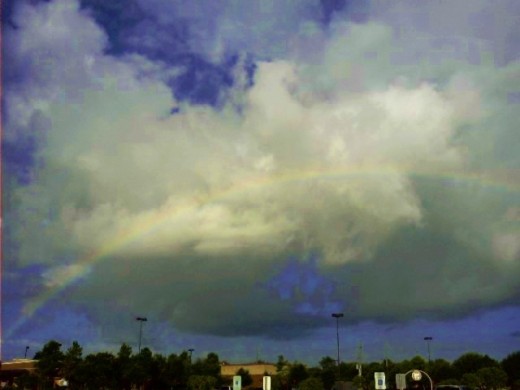Easy and Fun Color Science Activities

By Joan Whetzel
In science, the light waves that produce the colors we see, fall into a band ranging from red light (on lower frequency end) to violet (on the higher frequency end). When all of the colors are mixed and reflected back toward our eyes, they appear as white. When all of the colors are absorbed by an object or surface, they appear as black. The following activities were designed to help younger kids (pre-k through 1st or 2nd grade) to gain a basic understanding of light, pigment and color. They are great for a little summer fun as well as school science activities.
The Science of Color Mixing
This pre-k / kindergarten activity needs the following supplies for each student or small group of students (3 to 4):
· 6 Clear Plastic Cups
· 6 Craft Sticks
· 1 Paint Brush
· Painting Paper
· Tempera Paints, primary colors
· A Water Cup, for rinsing brushes
· Newspaper
· Paint Aprons, or anything that will protect their clothes
Purpose: To help children understand how pigment colors mix.
1. Spread out the newspaper on a table.
2. Place the cups, paint brushes, craft sticks, painting paper, water cup, and tempera paints on the newspaper covered paper.
3. Partially fill three of the clear cups with a small amount of the primary color tempera paints - one red, one blue, and one yellow.
4. Next, pour a small amount of two primary colors into the next three clear cups. One cup with blue and yellow, the second cup with blue and red, and the third cup with red and yellow.
5. Place one craft stick into each paint cup.
6. First ask kids to put on their paint aprons or clothing protections. Next, have the kids mix the paint in the paint cups. They should be able to state whether nothing changed (with the primary color cups) or whether the color changed (with the secondary color cups).
7. Ask the kids to tell you what primary colors were used to create the secondary colors. Then go on to explain how pigments create the primary and secondary colors.
8. Let the kids create lovely pictures with the paint.
In this activity, pre-k or kindergarten students receive 6 clear plastic cups and 6 craft sticks, a paint brush, painting paper, and a water cup for rinsing paint brushes. Partially fill 3 cups with primary colored tempura paints, and the other three with a small amount of a red/blue, blue/yellow, or yellow/red combination. Students will mix the combination paint cups to discover secondary colors. Students can then paint a picture of their choice using the primary and secondary colors and the water cup to clean their brushes between colors.
The Science of Color Separation
What's Needed:
· 1 Coffee Filter, per child
· Pencil
· Water-Soluble Markers
· 2 Tablespoons Water
· Clear Plastic Cup
Instructions:
1. Have each child flatten out a coffee filter to create a folded over half-circle.
2. Have them draw an arched pencil line about 2 inches from the flat edge of the coffee filter.
3. Tell the kids to use the water-soluble markers to color the coffee filter above the pencil line in one solid color.
4. Pour 2 Tbsp of water into each child's clear plastic cup.
5. Tell the kids fold the coffee filters again so that they form a pie shape - 1/4 circle.
6. They should place the decorate coffee filters into the cup or water, with the marker portion touching the water.
7. Tell them to sit back and watch as the colors separate and leach upward into the white portion of the coffee filter.
8. Afterward, they can unfold the coffee filter and let their design dry.
Disappearing Color Science
What's Needed for Each Child:
· Paper Plate
· Pencil
· Ruler
· Crayons
· 1" Long Wooden Dowel, small diameter
Instructions:
1. Make sure each child has their own set of the above supplies.
2. Tell students to draw lines, using the pencil and ruler. The lines start at the center of the paper plate and radiate outwards to create 6 evenly sized wedge-shapes. They should do this on both sides of the plate.
3. On one side of the paper plate, the kids should color each wedge a different color of the rainbow - red, orange, yellow, green, blue and purple.
4. On the second side, have them color alternating primary colors - either red and yellow, red and blue, or blue and yellow - so that they have three wedges of each color.
5. Punch a hole in the center of each paper plate, just large enough for the wooden dowel to fit snuggly, then insert the dowel into that hole.
6. Have the kids spin the plate on the dowel on the multi-colored side, this should produce an optical illusion that the colors have disappeared and the plate has returned to white.
7. Have the kids spin the plate on the alternating colors side. This should create an optical illusion of the secondary colors that their alternating colors would produce when mixing them together.
The Science of Refraction
Refraction is the separation of light into its component colors. What's need for this experiment is:
· Prism
· Light Source
· Large White Surface (white board, construction paper, cardboard)
Instructions:
1. Before starting this experiment, have the kids hypothesize about what they think will happen when the light is shined through the prism. If they know something about refraction, have them guess in what order the colors will appear.
2. Place the light on the same level as the prism, with the white surface on the other side of the prism. Note: the angle of the light with respect to the white surface can be tweaked to optimize the refraction of the light.
3. Turn off the room lights.
4. Turn on the light source and let the kids adjust the prism to get the best refraction. Let them tell you what they are observing.
5. For a little added visual effects: use different shaped prisms and crystals to produce different patterns to the refraction.
These experiments are simple, which makes them ideal for a younger audience. For those of you with smaller kids at home, try a few of these the next time your kids are stuck inside the house on a rainy day or an afternoon when it's way too hot to play outside.
References
Science for Preschoolers: Mix a Rainbow
http://scienceforpreschoolers.com/archives/154
Science for Preschoolers: Color --- Preschool Lesson Plan
http://scienceforpreschoolers.com/topic/physics/color-science
Education.com: Color Science for Kinders
http://www.education.com/activity/article/Color_Science_kindergarten/
Education.com: Spinning Science --- Disappearing Colors! By Alicia Danyali
http://www.education.com/activity/article/disappearing_color_science_first/
Free Science Fair Projects: What Do Raindrops Have to Do With White Light and Rainbow?
http://www.free-science-fair-projects.net/science-fair-projects-on-light-and-rainbows.html
Tripod: Math Activities
http://members.tripod.com/~Patricia_F/mathscience.html
Kindergarten Lessons: Light and Color Activities
http://www.kindergarten-lessons.com/light_and_color.html
Kindergarten Lessons: Light Science Activities for Kids
http://www.kindergarten-lessons.com/science-activities-for-kids.html
Educational Innovations: Light and Color









